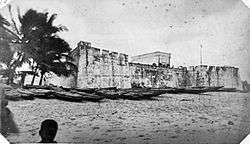Anomabu
| Anomabu | |
|---|---|
| Town | |
 Fort William in the 1870s | |
 Anomabu Location of Anomabu in Central Region in Ghana | |
| Coordinates: 5°10′N 1°7′W / 5.167°N 1.117°WCoordinates: 5°10′N 1°7′W / 5.167°N 1.117°W | |
| Country |
|
| Region |
|
| District | Mfantsiman Municipal |
| Population (2013) | |
| • Total | 14,389[1] |
| Time zone | GMT |
| • Summer (DST) | GMT |
Anomabu, also spelled Anomabo and formerly as Annamaboe,[2] is a town on the coast of the Mfantsiman Municipal District of the Central Region of Ghana. Anomabu has a settlement population of 14,389 people.[1]
History
Fort William, also known as Anomabu Castle, was designed by the British engineer John Apperley and constructed between 1753 and 1760. At the time it was considered to be the strongest fortification on the coast.[3] It is about 16 kilometers (10 mi) from Cape Coast Castle.[2] After his death in 1756, Irishman Richard Brew took over the Governorship of the fort and continued its construction. The Anomabu fort became the center of British slave trading along the Gold Coast until the practice was outlawed in 1807.[4] In the same year, a small garrison successfully resisted the entire Ashanti army, although the city suffered greatly from the attack.[2] In the later 19th century, it exported in palm oil, ivory, gold dust, peanuts, and Guinea grains in exchange for considerable imports of manufactured goods.[2] Its population in the 1870s was around 4500.[2]
Originally a small fishing village, Annamaboe eventually became one of the most important trading ports on the Gold Coast. By the 18th century, the town had become one of the largest exporters of slaves on the West Coast of Africa.[5]
Tourism
In modern times, Anomabu is a popular tourist destination. The remains of Fort William are still visible.[6]
Festivals
The people of Anomabo celebrate the Okyir festival which is a week-long annual festival[7] celebrated in the second week in the month of October.[8] "Okyir" means "abomination" and the people celebrate this festival as a reminder of society's social vices.[9]
Notable residents
References
- Citations
- 1 2 "World Gazetteer online". World-gazetteer.com. Archived from the original on 2012-01-11.
- 1 2 3 4 5 EB (1878).
- ↑ The National Cyclopaedia of Usefuk Knowledge,; Vol I (First ed.). London: Charles Knight. 1847. p. 770.
- ↑ St Clair (2006), Ch. 7.
- ↑ Sparks, Randy (2014). Where the Negroes Are Masters. Cambridge, Massachusetts: Harvard University Press. p. 7.
- ↑ Ghana Slave Forts
- ↑ "Anomabo celebrates Okyir festival". www.ghanaweb.com. Retrieved 2018-04-19.
- ↑ "Central region celebrates Okyir". Today Newspaper. 2015-10-21. Retrieved 2018-04-19.
- ↑ Sey, Magdalene (2008-10-14). "Ghana: Anomabo Celebrates Okyir in Grand Style". Ghanaian Chronicle (Accra). Retrieved 2018-04-19.
- Bibliography
- "Annamaboe", Encyclopædia Britannica, 9th ed., Vol. II, New York: Charles Scribner's Sons, 1878, p. 61 .
- St Clair, William (2006), The Grand Slave Emporium: Cape Coast Castle and the British Slave Trade, Profile Books .
Further reading
- Shumway, Rebecca. 2011. "The Fante and the Transatlantic Slave Trade." Rochester: University of Rochester Press. ISBN: 9781580463911
- Sparks, Randy J. (2014), Where the Negroes are Masters: An African Port in the Era of the Slave Trade, Cambridge: Harvard University Press .
![]()

